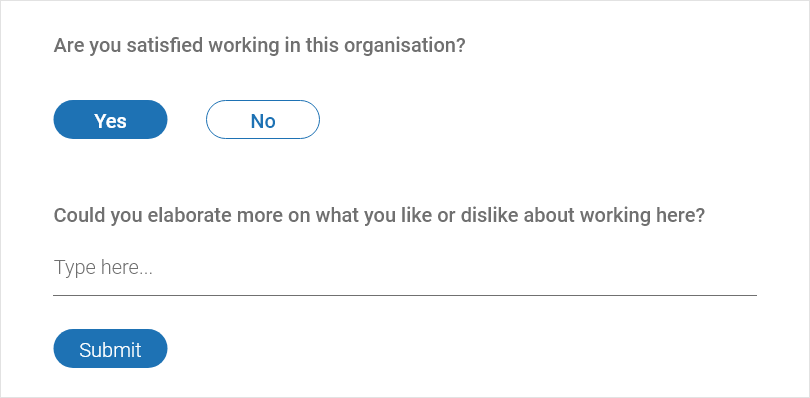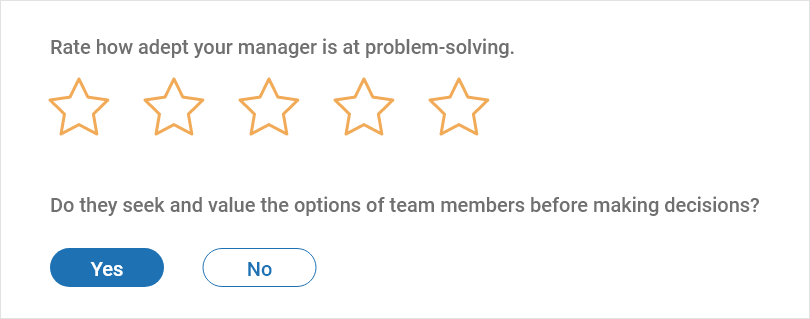
“Feedback is the breakfast of champions.” – Ken Blanchard
How often have we pondered upon the path to becoming the best version of ourselves?
As personal and professional landscapes transform, innovative feedback mechanisms unlock new possibilities for learning, skill development, and success.
When we want that same growth for an organization as a whole, feedback questions become indispensable tools to advance on the journey.
360 feedback, in particular, has emerged as a potent tool for understanding oneself as an employee.
In this blog, you will find strategies to create meaningful 360 feedback questions, sample questions, and some readymade templates for overall employee growth.
Let’s begin.
What Makes for Excellent 360 Feedback Questions?
When it comes to gathering feedback through a 360-degree feedback process, the quality and effectiveness of the questions play a crucial role in obtaining valuable insights.
Here are some key considerations for creating excellent 360 feedback questions:
- Alignment with Competencies or Skills: Start by identifying the core competencies or skills that are relevant to the individual receiving feedback. The questions should align with these competencies to assess performance effectively.
- Clear and Specific: Each question should be clear and specific, leaving no room for ambiguity. Vague or general questions may lead to confusing or unreliable feedback. Ensure that respondents easily understand the meaning of the question.
- Behavior-Focused: Construct questions that direct respondents to evaluate specific behaviors or actions rather than making general conclusions or assumptions. This encourages objective feedback based on observed actions or interactions.
- Actionable and Development-Oriented: Ask questions that generate feedback and can also be translated into actionable steps for improvement and professional growth. The purpose of 360 feedback is to support development, so the questions should provide guidance for future actions.
- Balanced and Fair: Balance the questions to gather feedback on both strengths and areas for improvement. This helps create a well-rounded view of an individual’s performance and avoids biases or skew towards negative feedback.
- Open-Ended and Closed-Ended Combination: Utilize a mix of open-ended questions and closed-ended questions in your 360 feedback survey. Open-ended questions allow for detailed responses and provide valuable qualitative feedback. Closed-ended questions, such as rating scales or multiple-choice questions, can provide quantifiable data for comparison and analysis.
- Tailored to Different Stakeholders: Consider the perspectives of different stakeholders involved in the feedback process, such as supervisors, peers, and direct reports. Craft questions that are appropriate for each group, allowing for nuanced feedback from various angles.
Want to Gather 360° Employee Feedback? 💡
Collect valuable feedback to nurture growth and performance.
How to Write Well-Phrased 360 Feedback Questions – Top 5 Strategies to Follow
Do you know the key to correct responses from the respondents?
Well, asking the right questions just about sums it up! However, as simple as it may sound, a lot goes into designing and drafting a well-structured 360-degree feedback questionnaire.
The results of 360 feedback questions and answers are best when the approach is qualitative instead of quantitative.
Let’s first understand the elements to be included in questions for 360 feedback. These elements increase the effectiveness of the performance survey.
- First and foremost, no bias in the questionnaire.
- Questions to include in the survey should be personality and performance-based.
- Questions should be relevant and specific and should not confuse the respondent.
- The questions should highlight the respondent’s commitment and contribution to the organization.
Now, let’s find out the top 5 strategies for writing questions for 360-degree feedback in detail.
1. Include Suitable Question Types
The answers to the survey depend on the kind of questions asked. Asking one type of question throughout the survey will kill its purpose. Thus, balancing the perfect mix of questions (including both open-ended and closed-ended).
Open-ended questions help you understand the context and gain deep insights into the behavior. The respondents can answer their reasons and other essential aspects. Close-ended questions provide a quick and straightforward way to analyze the data.
2. Use Simple Language
It may sound basic, but one should not neglect it. Any heavy technical terms/jargon in the survey will lead to confusion, and the respondent may fail to answer correctly.
Simple language also ensures that the meaning is conveyed as expected. Avoid lengthy questions and contextless questions.
For example, see the question below:
“On a scale from 1 to 5, rate your overall satisfaction with the customer service provided by our helpdesk team.”
Vs.
“How satisfied were you with the assistance you received from our support team? Please choose a number from 1 to 5, where 1 means ‘Very Unsatisfied’ and 5 means ‘Very Satisfied’.”
The first approach sounds complicated and may take reading it twice to fully understand your query (and your respondents may simply not have the time). The second approach, however, clarifies what you want to know much better and has a higher chance of fetching a response!
3. Ask the Right Number of Questions at the Right Time
Avoid overloading your 360 feedback survey with questions. Try spacing the questionnaires throughout the year to know about relevant issues instead of handing them over once annually. According to experts, you can hit the sweet spot by conducting 360 feedback surveys quarterly – this prevents the dilemma of too many vs. too little quite nicely!

With this practice, your employees can understand their development opportunities from time to time, and they can take steps for improvement. You can even use certain feedback software to speed up the data process.
4. Keep the Process Easy & Simple
You are likely to experience a low response rate if you have created a complicated process. Lengthy surveys will bore the respondents, and they may tend to skip participating. Therefore, a survey should include not more than 50 questions; that is too specific and to the point. The respondent should not feel like goose chasing.
On top of that, the evaluation should also be simple and easy. Complicated evaluations can take too much time to process the data. A delay in the results further disturbs the entire evaluation process. This ultimately defeats the purpose.
5. Ensure Relevancy to the Role and Organization
Relevancy is an important aspect of writing 360-degree feedback questionnaires. The questions you want to ask should include all the major pillars of functional and behavioral aspects of the employee in the organization.
Overburdening the employee with too many questions that don’t fall in their domain may lead to unnecessary confusion.
For example, if you are to ask 360 feedback questions to an account manager, you don’t need to include questions related to sales and marketing.
Types of 360 Feedback Questions
Businesses use a mix of questions in 360-degree feedback surveys. The answers to these questions are given with the help of a rating scale. Though most of the questions are closed-ended, there are open-ended questions, which let the respondents explain anything they want to emphasize.
1. 360 Feedback Questions for Overall Performance Assessment
360 feedback questions for performance assessment involve gathering feedback from multiple perspectives, including supervisors, peers, subordinates, and sometimes even customers or clients.
The all-encompassing approach provides employees with a broader view of their strengths and areas for improvement.
When designing 360-degree feedback questions for overall performance assessment, focus on both the individual’s skills and behaviors and their impact on the team and organization.
Here are some sample questions:
1.1 Self-Assessment Questions:
- What do you perceive as your key strengths in the workplace?
- What areas do you believe you could improve upon to enhance your overall performance?
- How well do you think you collaborate with others and foster a positive work environment?
- How effectively do you handle and adapt to changes or challenges in your role?
- Are you satisfied with your current work-life balance, and do you believe it affects your performance?

1.2 Peer Assessment Questions:
- How well does the individual communicate and listen to others’ perspectives and ideas?
- How effectively do they contribute to team projects and support team members?
- Do they demonstrate strong problem-solving and decision-making skills?
- How well do they handle constructive feedback and incorporate it into their work?
- To what extent do they demonstrate leadership qualities and inspire others?
1.3 Supervisor Assessment Questions:
- How well does the individual meet their performance objectives and achieve their goals?
- How effectively do they prioritize tasks and manage their time?
- Do they demonstrate initiative and take ownership of their responsibilities?
- How well do they handle and resolve conflicts with colleagues or clients?
- Are they receptive to feedback and willing to develop new skills or knowledge?


1.4 Subordinate Assessment Questions (if applicable):
- How well does the individual support their subordinates’ professional development and growth?
- Do they provide clear guidance and direction to their team?
- How well do they listen to their subordinates’ concerns and address any issues that arise?
- Do they demonstrate fairness and consistency in their interactions with their team?
- How well do they recognize and appreciate their subordinates’ contributions?
1.5 Customer/Client Assessment Questions (if applicable):
- How well does the individual understand and meet the needs of customers or clients?
- Do they effectively handle inquiries and resolve issues in a timely manner?
- How well do they build and maintain positive relationships with customers or clients?
- Are they receptive to feedback and suggestions from customers or clients?
- Do they consistently deliver high-quality products or services?
2. 360 Feedback Question Examples to Assess Workplace Efficiency
These questions assess employee satisfaction level with supervisors, interpersonal communication and relationships, leadership potentials, and their overall commitment to the organization.
Let’s see some sample questions for this type as well!
2.1 360 Feedback Questions to Increase Managerial Efficiency
These questions are designed to understand the leadership effectiveness and other key aspects of the managers at the workplace. The employees who are directly working with the managers to be surveyed answer these questions.
- Is the manager respectful in their interactions with others?
- Do they seek and value the opinions of team members before making decisions?
- How adept is the manager at problem-solving?
- Is the manager responsive and attentive to their team’s needs and inquiries?
- Can the manager handle pressure and meet deadlines effectively?
- Does the manager provide a clear and compelling vision that aligns with the organization’s objectives?


2.2 Employee Communication
These types of questions highlight the importance of communication and the level of openness among the employees. The outcome of the survey helps the organization bridge any gap.
- Does the employee interact with others respectfully and professionally?
- Does the employee consider colleagues’ opinions before making decisions?
- How effectively does the employee solve problems?
- Is the employee responsive to team needs and questions?
- Can the employee handle pressure and meet deadlines?
- Does the employee communicate a clear vision aligned with organizational objectives?


2.3 Leadership Potential
- Does the employee take initiative and provide effective solutions to customer problems?
- Is the employee seen as a leader in their daily work?
- Does the employee take ownership of their tasks and meet deadlines consistently?
- Do other team members seek the employee’s assistance and guidance?
- Does the employee handle their duties without encountering significant issues?
- Does the employee actively contribute ideas and participate in problem-solving discussions?
- Does the employee demonstrate efficient supervision skills when required?


2.4 Interpersonal Skills
- Does the employee work effectively with others on collaborative tasks?
- Does the employee consistently show respect and consideration to their team members?
- How well does the employee manage and control their emotions in various situations?
- Does the employee effectively handle and manage their stress levels?
- Does the employee experience frequent conflicts with others in the workplace?
- Does the employee align with the core values of the organization in their interactions?
- Is the employee a reliable source of advice and support for other staff members?
2.5 Problem-Solving Potential
- Is the employee skilled at analyzing and evaluating problems?
- Does the employee offer valuable and practical solutions to various challenges?
- How well does the employee identify and communicate existing problems to others?
- Does the employee work well independently to resolve issues?
- Does the employee feel confident in exploring and tackling problems autonomously?
- Does the employee display creativity in providing solutions to problems?
- Does the employee grasp the implications and dependencies of the problems they encounter?
2.6 Organizational Sync
- Does the employee demonstrate awareness of the organization’s goals and objectives?
- Are they familiar with the strategic vision of the organization?
- Does the employee consistently exhibit the company’s core values in their actions?
- Do they actively participate in discussions related to the organization during meetings?
- Is the employee an advocate for the company when interacting with customers?
- Does the employee show genuine engagement with the organization’s goals?
- Do they actively provide feedback on organization-related ideas or initiatives?
2.7 Motivation & Commitment Level
- Does the employee visibly display motivation for their job and responsibilities?
- How well does the employee communicate their motivation in their work?
- Are there specific tasks that seem particularly challenging to motivate the employee to complete?
- What is the overall level of motivation observed in the employee’s work?
- Does the employee proactively share their work with others, driven by motivation?
- Do they motivate and inspire others when working on group tasks?
2.8 Workplace Efficiency
- Does the employee consistently complete their tasks effectively and efficiently?
- How well does the employee foster a collaborative environment when working with others?
- Does the employee handle daily work tasks in a smooth and efficient manner?
- Are the employee’s work outputs consistently at the expected level of quality?
- Does the employee consistently meet deadlines for their work assignments?
- Does the employee strive for excellence and exceed expectations in their work?
- Does the employee actively seek to improve processes to enhance efficiency?
3. Open-Ended Questions for 360-Degree Feedback Assessments
When it comes to using open-ended questions, you’ve got some creative freedom. You can choose to place them after each question, digging into the specific reasons behind participants’ answers, or at the end of the close-ended questions to capture broader thoughts and reflections beyond the predefined choices.
Here are a few examples to get you started:
3.1 After each close-ended question:
- Could you elaborate on your answer?
- Why did you choose this response?



3.1 At the end of all close-ended questions:
- What else would you like to share about this employee?
- What has this employee excelled at?
- How can this employee become even more effective in their role?
- Any additional comments?
- Can you provide specific examples?
- How would you rate their performance in [add specific attribute]?
4. Sample 360 Feedback Question on Core Competencies
Here’s a 360 Feedback template designed to gather insights on a colleague’s employee performance.
Each segment of the template centers on distinct attributes: Communication, Strategic Mindset, Decision Making, and Leading the Team.
These samples will help kickstart your survey or serve as benchmarks for your current approach. Let’s begin:
| Hello,
Thank you for participating in this 360-degree survey. Here are some essential leadership principles that are effective for (Subject Name). Please provide your valuable feedback for [Subject Name]’s development. Section 1: Communication How effectively does [Subject Name] communicate their ideas and thoughts to others?
How well does [Subject Name] listen and respond to others’ viewpoints and feedback?
Does [Subject Name] convey information in a clear and concise manner?
Section 2: Strategic Mindset Does [Subject Name] demonstrate a clear understanding of the organization’s strategic goals and objectives?
How proactive is [Subject Name] in identifying opportunities and potential challenges in their work?
Section 3: Decision Making Does [Subject Name] make well-informed and thoughtful decisions?
How receptive is [Subject Name] to feedback and input from others when making decisions?
Section 4: Leading the Team How effectively does [Subject Name] motivate and inspire team members?
Does [Subject Name] provide clear direction and guidance to the team?
How well does [Subject Name] resolve conflicts within the team?
Additional Comments:
Thank you for your valuable input! Your insights will contribute to the growth and development of [Subject Name]. |
Build the Perfect 360 Feedback Questionnaire for your Employees
360-degree feedback surveys hold a treasure trove of benefits when executed correctly and at the right time. The Human Resources Department and managers alike can tap into these invaluable results to evaluate employee performance.
With the carefully crafted 360 feedback questions mentioned above, we are sure that you will not only elevate individual employees but also propel the entire organization to new heights.
Feeling uncertain about conducting your first feedback survey? Allow us to introduce you to the ProProfs Survey Maker– a robust tool equipped with 100,000+ survey templates and sample questions for 360 feedback.
FREE. All Features. FOREVER!
Try our Forever FREE account with all premium features!





